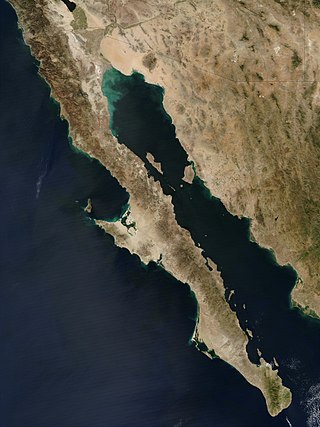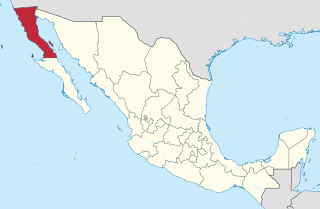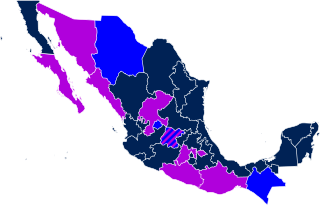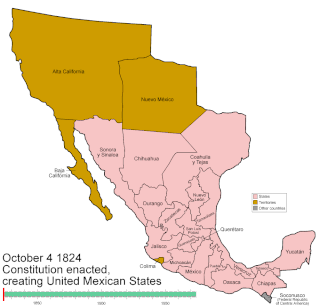
The Baja California peninsula is a peninsula in northwestern Mexico. It separates the Gulf of California from the Pacific Ocean. The peninsula extends from Mexicali, Baja California, in the north to Cabo San Lucas, Baja California Sur, in the south.

The United Mexican States is a federal republic composed of 32 federal entities: 31 states and Mexico City, an autonomous entity. According to the Constitution of 1917, the states of the federation are free and sovereign in all matters concerning their internal affairs. Each state has its own congress and constitution.

Baja California, officially the Free and Sovereign State of Baja California, is a state in Mexico. It is the northernmost and westernmost of the 32 federal entities of Mexico. Before becoming a state in 1952, the area was known as the North Territory of Baja California. It has an area of 70,113 km2 (27,071 sq mi) and comprises the northern half of the Baja California Peninsula, north of the 28th parallel, plus oceanic Guadalupe Island. The mainland portion of the state is bordered on the west by the Pacific Ocean; on the east by Sonora, the U.S. state of Arizona, and the Gulf of California; on the north by the U.S. state of California; and on the south by Baja California Sur.

Baja California Sur, officially the Free and Sovereign State of Baja California Sur, is the least populated state and the 31st admitted state of the 32 federal entities which comprise the 31 States of Mexico. It is also the ninth-largest Mexican state in terms of area.

La Paz is the capital city of the Mexican state of Baja California Sur. The city had a 2020 census population of 250,141 inhabitants, making it the most populous city in the state. Its metropolitan population is somewhat larger because of the surrounding towns, such as El Centenario, Chametla and San Pedro. It is in La Paz Municipality, which is the fourth-largest municipality in Mexico in geographical size and reported a population of 292,241 inhabitants on a land area of 20,275 km2 (7,828 sq mi).

Lesbian, gay, bisexual, and transgender (LGBT) rights in Mexico have expanded in recent years, in keeping with worldwide legal trends. The intellectual influence of the French Revolution and the brief French occupation of Mexico (1862–67) resulted in the adoption of the Napoleonic Code, which decriminalized same-sex sexual acts in 1871. Laws against public immorality or indecency, however, have been used to prosecute persons who engage in them.

Same-sex marriage is legally recognized and performed throughout Mexico since 31 December 2022. On 10 August 2010 the Supreme Court of Justice of the Nation ruled that same-sex marriages performed anywhere within Mexico must be recognized by the 31 states without exception, and fundamental spousal rights except for adoption have also applied to same-sex couples across the country.

The Californias, occasionally known as The Three Californias or Two Californias, are a region of North America spanning the United States and Mexico, consisting of the U.S. state of California and the Mexican states of Baja California and Baja California Sur. Historically, the term Californias was used to define the vast northwestern region of Spanish America, as the Province of the Californias, and later as a collective term for Alta California and the Baja California Peninsula.

Mexico has experienced many changes in territorial organization during its history as an independent state. The territorial boundaries of Mexico were affected by presidential and imperial decrees. One such decree was the Law of Bases for the Convocation of the Constituent Congress to the Constitutive Act of the Mexican Federation, which determined the national land area as the result of integration of the jurisdictions that corresponded to New Spain, the Captaincy General of Yucatán, the Captaincy General of Guatemala and the autonomous Kingdoms of East and West. The decree resulted in the independence from Spain.
The Autonomous University of Baja California Sur is a Mexican public university based in the state of Baja California Sur.

Baja California Territory was a Mexican territory from 1824 to 1931, that encompassed the Baja California peninsula of present-day northwestern Mexico. It replaced the Baja California Province (1773–1824) of the Spanish colonial Viceroyalty of New Spain, after Mexican independence. Along with Alta California, the two territories were split from the Spanish Californias region.
Events in the year 1952 in Mexico.

Víctor Manuel Castro Cosío is a Mexican politician currently affiliated with the National Regeneration Movement. He is the governor of Baja California Sur.

The Territory of Baja California Sur was a Mexican federal territory that existed from 1931 to 1974. Its former area currently comprises the Mexican state of Baja California Sur, located in the southern part of the Baja California peninsula.
Same-sex marriage has been legal in Baja California since 3 November 2017 when the Secretary General of Government, Francisco Rueda Gómez, instructed the state's civil registry to immediately begin issuing marriage licenses to same-sex couples and cease enforcement of the state's same-sex marriage ban. This was in line with jurisprudence established by the Mexican Supreme Court, which has ruled that same-sex marriage bans violate Articles 1 and 4 of the Constitution of Mexico. Previously, Baja California had banned same-sex marriage both by statute and in its state constitution.
Same-sex marriage has been legal in Baja California Sur since 29 June 2019. On 27 June, the state Congress passed a bill opening marriage to same-sex couples. It was published in the official state gazette on 28 June and took effect the following day, legalizing same-sex marriage in Baja California Sur.
Alfonso García González was a Mexican politician. He was the last governor of the North Territory of Baja California and the first provisional governor of the State of Baja California.

Province of Las Californias was a Spanish Empire province in the northwestern region of New Spain. Its territory consisted of the entire U.S. states of California, Nevada, and Utah, parts of Arizona, Wyoming, and Colorado, and the Mexican states of Baja California and Baja California Sur.














